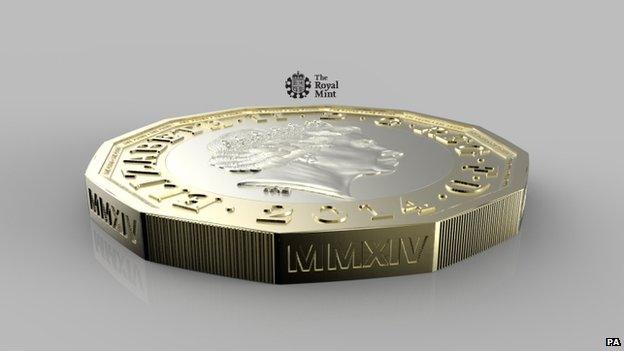New pound coin designed to combat counterfeiting
- Published
- comments

The Royal Mint is introducing the new coin as it believes 3% of existing £1 coins are fake
A new £1 coin, billed by the Royal Mint as the "most secure coin in the world", is to be introduced in 2017.
The move comes amid concerns about the 30-year old coin's vulnerability to counterfeiting, with an estimated 45 million forgeries in circulation.
The new coin is based on the design of the old threepenny bit, a 12-sided coin in circulation between 1937 and 1971.
A competition will be held to decide what image to put on the "tails" side of the coin.
'More resilient'
In his Budget statement to the Commons, Chancellor George Osborne said: "The prerequisite of sound money is a sound currency."
The Royal Mint's Andrew Mills says introducing the £1 coin could cost £20m
He said the £1 coin was one of the oldest coins in circulation and had become "increasingly vulnerable to forgery".
"One in 30 pound coins is counterfeit, and that costs businesses and the taxpayer millions each year," Mr Osborne continued.
"So I can announce that we will move to a new, highly secure, £1 coin. It will take three years.
"Our new pound coin will blend the security features of the future with inspiration from our past.
"In honour of our Queen, the coin will take the shape of one of the first coins she appeared on - the threepenny bit.
"A more resilient pound for a more resilient economy."
'High-speed authentication'
The government said it would hold a detailed consultation on the impact of the change on businesses, which may face costs from having to change vending machines, supermarket trolleys and lockers at gyms and leisure centres.
Some commentators have raised fears the new piece will not work smoothly in vending machines but the Royal Mint said the coin "will be expressly designed to fit existing mechanisms".
It said the move would increase public confidence in the UK's currency and reduce costs for banks and other businesses.
Earlier, the chancellor tweeted this picture of the £1 coin next to the Budget box, external, captioned: "Today I will deliver a Budget for a resilient economy - starting with a resilient pound coin."

Mr Osborne posted this picture on Twitter on Wednesday morning
The current £1 coin was introduced in 1983 as part of the phasing-out of the Bank of England £1 note, which was withdrawn five years later.
Of the 1.5 billion estimated to be in circulation, as many as two million counterfeit ones are removed every year.

The new coin has been modelled on the old threepenny bit
The proposed new coin will be roughly the same size as the current one and will be based on the threepenny piece that disappeared after decimalisation in the early 1970s.
The new coin will be made in two colours and will incorporate state-of-the-art technology to ensure it can be "authenticated via high-speed automated detection at all points within the cash cycle", the government added.
While the Queen's head will be on the obverse side of the coin, as it is on all legal tender in the UK, the Treasury has said there will be a public competition to decide the image on the other side.
'Pioneering'
A Treasury spokesman said the time was right to "retire" the existing £1 coin and using the threepenny bit as inspiration for its replacement was a "fitting tribute" to such an iconic design.
"With advances in technology making high-value coins like the £1 ever more vulnerable to counterfeiters, it's vital that we keep several paces ahead of the criminals to maintain the integrity of our currency," he added.
Adam Lawrence, chief executive of the Royal Mint, which is based in Llantrisant, south Wales, said the process could change the way coins were made in the future.
"It is our aim to identify and produce a pioneering new coin which helps to reduce the opportunities for counterfeiting, helping to boost public confidence in the UK's currency in the process."
The Bank of England, which earlier this year announced banknotes would be made out of plastic rather than cotton from 2016, said the move would "enhance the security and integrity of the currency".